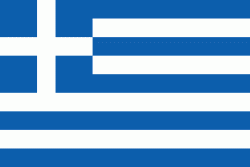Flag of Greece
The national flag of Greece, popularly referred to as the "blue and white one" (Γαλανόλευκη, Galanólefki) or the "sky blue and white" (Κυανόλευκη, Kyanólefki), is officially recognised by Greece as one of its national symbols and has nine equal horizontal stripes of blue alternating with white. There is a blue canton in the upper hoist-side corner bearing a white cross; the cross symbolises Eastern Orthodox Christianity. The blazon of the flag is Azure, four bars Argent; on a canton of the field a Greek cross throughout of the second. The official flag ratio is 2:3. The shade of blue used in the flag has varied throughout its history, from light blue to dark blue, the latter being increasingly used since the late 1960s. It was officially adopted by the First National Assembly at Epidaurus on 13 January 1822. The nine stripes do not have any official meaning; the most popular theory says that they represent the syllables of the phrase Ελευθερία ή Θάνατος ("Freedom or Death"), the five blue stripes for the syllables Ελευθερία and the four white stripes ή Θάνατος. The nine stripes is also said to represent the letters of the word "freedom" (ελευθερία). White and blue symbolise the colours of the Greek sky and sea.
The origins of today's national flag with its cross-and-stripe pattern are a matter of debate. Every part of it, including the blue and white colors, the cross, as well as the stripe arrangement can be connected to very old historical elements; however, it is difficult to establish "continuity", especially as there is no record of the exact reasoning behind its official adoption in early 1822.
It has been suggested by historians that the current flag derived from an older design, the virtually identical flag of the powerful Cretan Kallergis family. This flag was based on their coat of arms, whose pattern is supposed to be derived from the standards of their claimed ancestor, Byzantine Emperor Nicephorus II Phocas (963–969 AD). This pattern (according to not easily verifiable descriptions) included nine stripes of alternating blue and white, as well as a cross, assumed to be placed on the upper left. Although the use of alternating blue and white - or silver - stripes on (several centuries-old) Kallergis' coats of arms is well documented, no depiction of the above described pattern (with the nine stripes and the cross) survives.
The origins of today's national flag with its cross-and-stripe pattern are a matter of debate. Every part of it, including the blue and white colors, the cross, as well as the stripe arrangement can be connected to very old historical elements; however, it is difficult to establish "continuity", especially as there is no record of the exact reasoning behind its official adoption in early 1822.
It has been suggested by historians that the current flag derived from an older design, the virtually identical flag of the powerful Cretan Kallergis family. This flag was based on their coat of arms, whose pattern is supposed to be derived from the standards of their claimed ancestor, Byzantine Emperor Nicephorus II Phocas (963–969 AD). This pattern (according to not easily verifiable descriptions) included nine stripes of alternating blue and white, as well as a cross, assumed to be placed on the upper left. Although the use of alternating blue and white - or silver - stripes on (several centuries-old) Kallergis' coats of arms is well documented, no depiction of the above described pattern (with the nine stripes and the cross) survives.
National flag
Country - Greece
Warning: getimagesize(/Image/Map/MP390903.gif): failed to open stream: No such file or directory in /home/mapnlee7/public_html/MAPNALL/article.php on line 532
 |
 |
Greece is considered the cradle of Western civilization, being the birthplace of democracy, Western philosophy, Western literature, historiography, political science, major scientific and mathematical principles, theatre and the Olympic Games. From the eighth century BC, the Greeks were organised into various independent city-states, known as poleis (singular polis), which spanned the Mediterranean and the Black Sea. Philip II of Macedon united most of present-day Greece in the fourth century BC, with his son Alexander the Great rapidly conquering much of the ancient world, from the eastern Mediterranean to the North Western parts of India. The subsequent Hellenistic period saw the height of Greek culture and influence in antiquity. Greece was annexed by Rome in the second century BC, becoming an integral part of the Roman Empire and its continuation, the Byzantine Empire, which was culturally and linguistically predominantly Greek.
